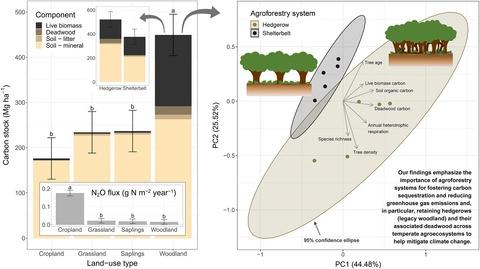当前位置:
X-MOL 学术
›
Glob. Change Biol.
›
论文详情
Our official English website, www.x-mol.net, welcomes your
feedback! (Note: you will need to create a separate account there.)
Agroforestry perennials reduce nitrous oxide emissions and their live and dead trees increase ecosystem carbon storage
Global Change Biology ( IF 10.8 ) Pub Date : 2022-07-15 , DOI: 10.1111/gcb.16322 Cole D Gross 1 , Edward W Bork 2 , Cameron N Carlyle 2 , Scott X Chang 1
Global Change Biology ( IF 10.8 ) Pub Date : 2022-07-15 , DOI: 10.1111/gcb.16322 Cole D Gross 1 , Edward W Bork 2 , Cameron N Carlyle 2 , Scott X Chang 1
Affiliation

|
Agroforestry systems (AFS) contribute to carbon (C) sequestration and reduction in greenhouse gas emissions from agricultural lands. However, previously understudied differences among AFS may underestimate their climate change mitigation potential. In this 3-year field study, we assessed various C stocks and greenhouse gas emissions across two common AFS (hedgerows and shelterbelts) and their component land uses: perennial vegetated areas with and without trees (woodland and grassland, respectively), newly planted saplings in grassland, and adjacent annual cropland in central Alberta, Canada. Between 2018 and 2020 (~April–October), nitrous oxide emissions were 89% lower under perennial vegetation relative to the cropland (0.02 and 0.18 g N m−2 year−1, respectively). In 2020, heterotrophic respiration in the woodland was 53% lower in shelterbelts relative to hedgerows (279 and 600 g C m−2 year−1, respectively). Within the woodland, deadwood C stock was particularly important in hedgerows (35 Mg C ha−1 or 7% of ecosystem C) relative to shelterbelts (2 Mg C ha−1 or <1% of ecosystem C), and likely affected C cycling differences between the woodland types by enhancing soil labile C and microbial biomass in hedgerows. Deadwood C stock was positively correlated with annual heterotrophic respiration and total (to ~100 cm depth) soil organic C, water-soluble organic C, and microbial biomass C. Total ecosystem C was 1.90–2.55 times greater within the woodland than all other land uses, with 176, 234, 237, and 449 Mg C ha−1 found in the cropland, grassland, planted saplings treatment, and woodland, respectively. Shelterbelt and hedgerow woodlands contained 2.09 and 3.03 times more C, respectively, than adjacent cropland. Our findings emphasize the importance of AFS for fostering C sequestration and reducing greenhouse gas emissions and, in particular, retaining hedgerows (legacy woodland) and their associated deadwood across temperate agroecosystems will help mitigate climate change.
中文翻译:

农林业多年生植物减少一氧化二氮排放,它们的活树和死树增加了生态系统的碳储存
农林业系统 (AFS) 有助于碳 (C) 封存和减少农业用地的温室气体排放。然而,先前未充分研究的 AFS 之间的差异可能会低估其减缓气候变化的潜力。在这项为期 3 年的实地研究中,我们评估了两种常见 AFS(树篱和防护林带)及其组成土地利用的各种碳库和温室气体排放:有树和无树的多年生植被区(分别为林地和草地)、新种植的树苗在加拿大艾伯塔省中部的草原和邻近的一年生农田。2018 年至 2020 年(~4 月至 10 月),多年生植被下的一氧化二氮排放量相对于农田低 89%(0.02 和 0.18 g N m -2 年-1, 分别)。2020 年,防护林中林地的异养呼吸比树篱低 53%(分别为 279 和 600 g C m -2 年-1)。在林地内,相对于防护林带(2 Mg C ha -1或小于生态系统 C 的 1%),并且可能通过增强灌木丛中的土壤不稳定 C 和微生物生物量来影响林地类型之间的 C 循环差异。枯木碳库与年异养呼吸和总(至约 100 厘米深度)土壤有机碳、水溶性有机碳和微生物生物量碳呈正相关。林地内的总生态系统碳含量是所有其他土地的 1.90-2.55 倍使用 176、234、237 和 449 Mg C ha -1分别见于农田、草地、种植树苗处理和林地。防护林和树篱林地的碳含量分别是相邻农田的 2.09 倍和 3.03 倍。我们的研究结果强调了 AFS 对于促进碳封存和减少温室气体排放的重要性,特别是在温带农业生态系统中保留树篱(传统林地)及其相关的枯木将有助于缓解气候变化。
更新日期:2022-07-15
中文翻译:

农林业多年生植物减少一氧化二氮排放,它们的活树和死树增加了生态系统的碳储存
农林业系统 (AFS) 有助于碳 (C) 封存和减少农业用地的温室气体排放。然而,先前未充分研究的 AFS 之间的差异可能会低估其减缓气候变化的潜力。在这项为期 3 年的实地研究中,我们评估了两种常见 AFS(树篱和防护林带)及其组成土地利用的各种碳库和温室气体排放:有树和无树的多年生植被区(分别为林地和草地)、新种植的树苗在加拿大艾伯塔省中部的草原和邻近的一年生农田。2018 年至 2020 年(~4 月至 10 月),多年生植被下的一氧化二氮排放量相对于农田低 89%(0.02 和 0.18 g N m -2 年-1, 分别)。2020 年,防护林中林地的异养呼吸比树篱低 53%(分别为 279 和 600 g C m -2 年-1)。在林地内,相对于防护林带(2 Mg C ha -1或小于生态系统 C 的 1%),并且可能通过增强灌木丛中的土壤不稳定 C 和微生物生物量来影响林地类型之间的 C 循环差异。枯木碳库与年异养呼吸和总(至约 100 厘米深度)土壤有机碳、水溶性有机碳和微生物生物量碳呈正相关。林地内的总生态系统碳含量是所有其他土地的 1.90-2.55 倍使用 176、234、237 和 449 Mg C ha -1分别见于农田、草地、种植树苗处理和林地。防护林和树篱林地的碳含量分别是相邻农田的 2.09 倍和 3.03 倍。我们的研究结果强调了 AFS 对于促进碳封存和减少温室气体排放的重要性,特别是在温带农业生态系统中保留树篱(传统林地)及其相关的枯木将有助于缓解气候变化。











































 京公网安备 11010802027423号
京公网安备 11010802027423号